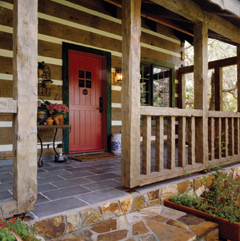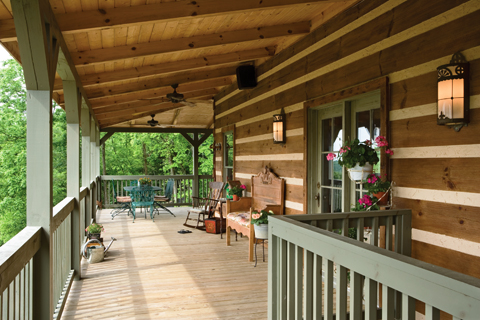There are different parts of a log home’s exterior that can make a real statement. It could be the log profile or the wraparound porch. Maybe it’s the roofline. But there is one element that is unmistakable: chinking. Chinking is that wide white strip between log courses that characterizes the exterior of some log homes. It is both eye catching and purposeful. “I find that customers are attracted to log homes with chinking for one of two reasons,” says Mathew Sterchi of StoneMill Log & Timber Homes in Knoxville, Tennessee. “One reason is for the look and feel of the style and, two, for its functionality.”
Chinking, as opposed to caulk, is most typically used when a joint area is larger than two inches. It is a synthetic material applied between log courses to protect against air and water infiltration. “Chinking adds greatly to the overall effectiveness of the entire building envelope by keeping heat and air from escaping during the heating and cooling seasons,” says Tony Huddleston of Perma-Chink Systems in Knoxville, Tennessee. “A properly applied chinking compound will also help keep out unwanted insects and other nuisance pests.”

StoneMill Log Homes/photo by Roger Wade
When it comes to log home styles, chinking lends itself to all profiles. It mainly depends on the desired look. For instance, the square log profile provides a groove especially for the product, giving it a pioneer or Appalachian style. For a Western flair, chinking goes well with a saddle-notch style.
No matter the profile, chinking is formulated to adhere to the logs and stretch to maintain its seal. Although the texture mimics the look of traditional mortar, it moves with the logs’ natural properties of expanding and contracting. Companies that specialize in chinking specifically for log homes know this and have formulated their products to adapt to the changes.
Today’s log home owners also have more choice when it comes to chinking colors. Once only available in white, chinking now comes in a range of neutrals including tans, grays, and browns. “There have been additions to the color palette of the products to keep up with the home owner’s desire to mix and match shades and hues of today’s finishes,” Huddleston says.
Chinking can be applied in a number of ways. Professional applicators sometimes use a chink pump, which is attached directly to the pail and pumps out the product. Or it can be applied using a caulking gun or a grout bag, similar to a cake-decorating bag, only bigger. Once the product has been applied, a trowel is used to remove any unwanted air and to ensure a good seal with the log surface. Then, the surface is lightly misted with water until the desired finish is achieved. To create a better seal and limit stress on the chinking, a type of backing is used between the wood and chinking, depending on the size of the groove. Also, application can be accomplished in a wide range of temperatures with little or no worries about product performance.

Perma-Chink Systems, Inc.
Although this may seem like a simple task, like caulking a tub, Joshua Watson of Honest Abe Log Homes in Moss, Tennessee, cautions DIYers to evaluate their skills before tackling this job. “Chinking can be a difficult task for a newbie,” says Watson. “Depending on factors such as the size of the job; the timeframe you have to finish; accessibility to the job, for instance, whether scaffolds will be needed; and previous or current trade skills, such as work with caulking or trowels in the past. All these things must be taken into account.” He also adds that a better end product will be achieved by hiring a professional to apply the product.
The maintenance requirements for chinking are relatively low. “Today’s chinking is 99 percent more maintenance-free than its predecessors, but it does require some maintenance,” says Watson. During a yearly inspection of the entire log home, remember to look at the chinking for any tears that can easily be patched with a tube of chinking. If over the years the color has faded, many companies now offer chink paint that is easy to apply and restores the color. “If you want chinking, go with reputable suppliers and a reputable applicator,” recommends Watson. “You want a company that stands behind that product just like you want a contractor to stand behind their work.”
Photography by Roger Wade Studio

